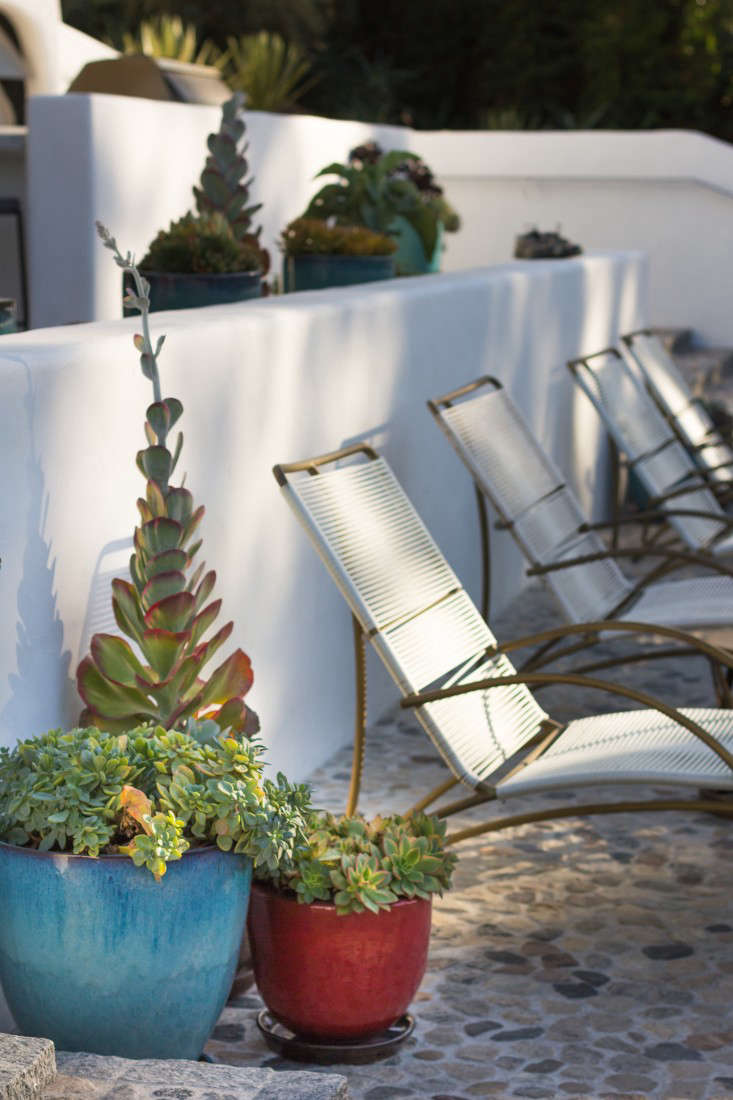We’re traveling to some of the driest gardens on earth–from Australia to Texas to Greece–to round up 11 eco-friendly landscape design tips that won’t force you to sacrifice style to save water. From shrubs and plants that need little water to clever hardscape hacks:
Celebrate Shade

A tree with a generous, spreading canopy can create a focal point in the garden and provide shade in a sunny, arid climate. As a general rule of thumb, the diameter of a tree’s canopy is an indication of the size of its root system underground, as well.
Planning to plant a tree? Our Trees 101 guide can help you choose the best tree for your garden (for each tree, see planting, care, and design tips on lifespan, canopy size, and drought tolerance).
Checkerboard Patio

In Seattle, garden designer Karen Stefonick cut back on the grass, assigning turf the task of growing in the joints of concrete pavers in a permeable patio. For more of this garden, see Sleekness in Seattle: Modern Garden, Midcentury House.
A patio paved with crushed stone or gravel is an inviting, forgiving surface and creates a permeable surface to prevent water runoff. For more ideas, see our design guide to Gravel 101 and Hardscaping 101: Decomposed Granite.
Drip Irrigation

Transformed troughs: livestock troughs with a small footprint–each is 2 feet wide and 6 feet long–sit side by side in the yard behind a San Francisco row house in a garden created by designer Katey Mulligan. At a height of 24 inches, each trough provides a luxurious depth of soil to promote root growth of vegetables and herbs. For more details, see Steal This Look: Water Troughs as Raised Garden Beds.
Gravel Ground

Texas landscape architect Christine Ten Eyck designed an outdoor dining space with gravel underfoot. The neutral color blends with natural surroundings. It’s a permeable paving material that feels good to walk on–and it captures groundwater.
See more ideas at Low-Cost Luxe: 9 Pea Gravel Patio Ideas to Steal.
Potted Plants

In Texas, architect professor John G. Fairey started work on his seven-acre Peckerwood garden four decades ago. For more, see A Texas Garden Where the Rare and Endangered Flourish.
Fairey saves water with container plants that he can water efficiently. Groupings of potted plants also can create architectural interest in spots where soil conditions are inhospitable.
Graywater

For more of this drought tolerant San Francisco garden by garden designer Beth Mullins, see A City Garden with a Spectacular View.
Recycle laundry and shower water–known as graywater–to use in the garden. Keep a bucket in the kitchen sink to rinse dishes and use it to water container plants.
Sunblock

A black awning provides shade and visual interest to a drought-resistant garden in Southern California. For more of this 2,100-square-foot stucco house, see All Eras Welcome: A Spanish Colonial Update in LA. Photograph by Laure Joliet.
Crowd Control

In the vegetable garden, plant edibles close together to minimize water requirements. For more organic edible gardening tips, see Gone Wild: How to Grow Vegetables in the Middle of Nowhere.
If you’re planning to plant an edible garden this spring, see our guide to Edibles 101 for growing tips (when to plant, days to maturity, and USDA growing zones for Carrots, Spinach, Tomatoes, Raspberries, Chives, Lemon Verbena, and more).
Boxwood

Extremely drought tolerant, boxwood is an evergreen that will provide color and structure year round in the garden. Find out more about the hardiest cultivars for your climate at our guide to Boxwoods 101.
Drifts of Color

Mass planting of a single variety of a drought tolerant plant can create a painterly swath of color in the garden. For a romantic combination (as shown above), combine Sedum ‘Autumn Joy’ (pink) with lavender (purple), and a silvery perennial grass (foreground). For more ideas, see A Garden You Water Four Times a Year.
Succulents

For an LA garden formerly owned by Howard Hughes, designer Kathleen Ferguson planted 80 containers, most with succulents. “They give another layer to areas where there are patio areas or terraces, to tie everything together,” Ferguson says.
Are you designing a new garden or just hoping to make yours more drought tolerant? For more ideas, see our Garden Design 101 guides to Decks & Patios 101, Fences & Gates 101, and Edible Gardens 101. See of our favorite low-water gardens:
- Before & After: An Artful Gravel Garden in Sonoma, California.
- Unconventional Wisdom: 8 Revolutionary Ideas for Your Garden from Thomas Rainer.
- 10 Ideas to Get the Groovy L.A. Look, from a Top Garden Designer.
- Garden Visit: Peckerwood in Texas, Where Rare and Endangered Plants Flourish.
- Designer Visit: Barbara Hill in Texas.
- Succulents & Cacti 101: A Field Guide to Planting, Care & Design.












Have a Question or Comment About This Post?
Join the conversation (2)